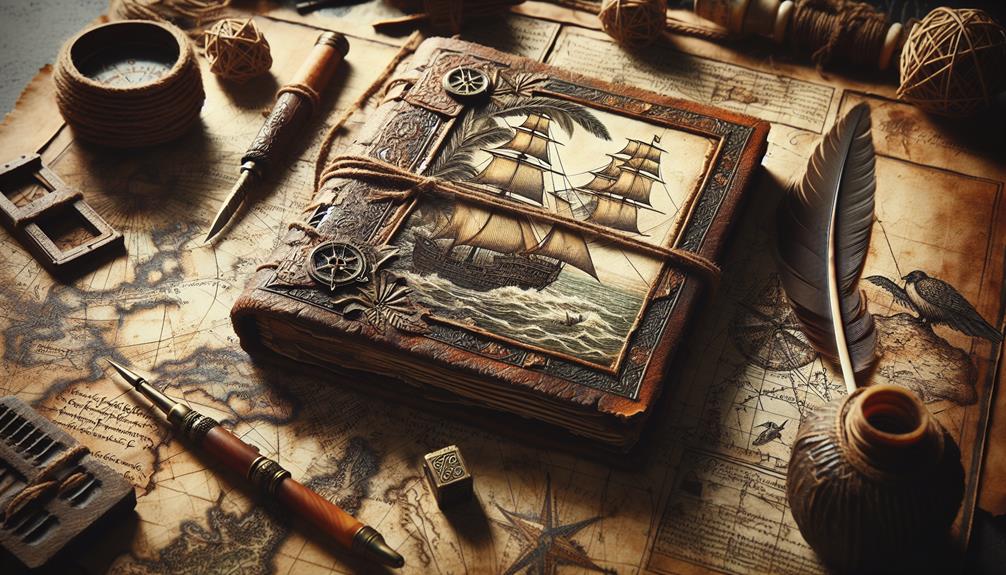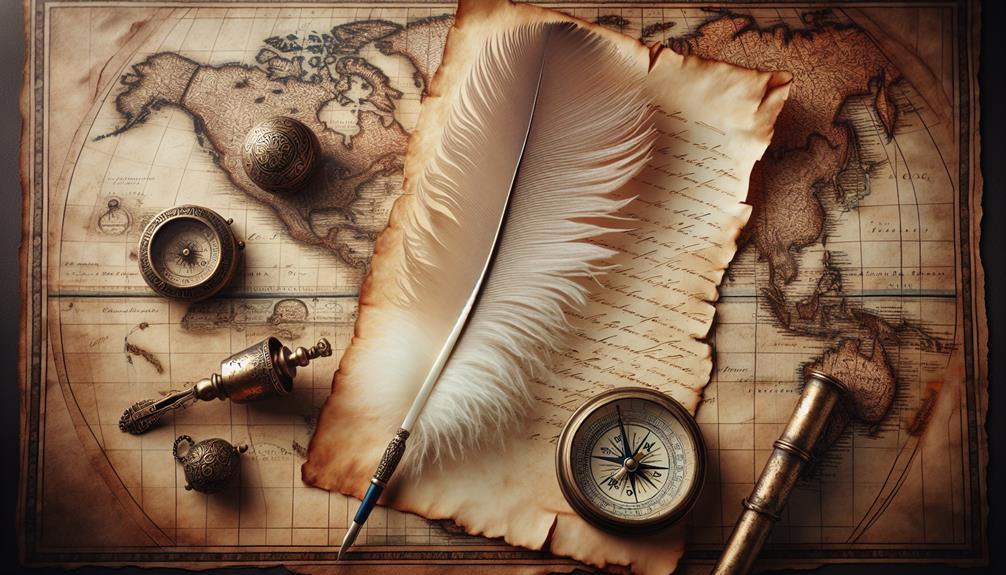Step back in time and embark on a journey through the pages of history, where travel writing reveals captivating tales of exploration and discovery. As you traverse the ancient lands, you will uncover the dusty scrolls of ancient travel writings, providing glimpses into the adventures of fearless wanderers. From the medieval narratives that transport you to a time of knights and castles, to the Renaissance accounts that chronicle the brave exploits of intrepid explorers, and the Enlightenment era journals that illuminate the minds of intellectual voyagers, each era offers a unique lens through which we can glimpse the world of our ancestors. But the journey doesn't end there; the 19th century beckons with its rich tapestry of travelogues, promising to transport you to distant lands and immerse you in the spirit of exploration. So, join us as we embark on this captivating exploration of historical perspectives in travel writing, where each turn of the page holds the promise of a new adventure.
Ancient Travel Writing

Ancient travel writing provides a fascinating glimpse into the journeys and observations of early explorers and historians. These accounts offer valuable insights into the ancient trade routes and the cultural exchanges that occurred along them. From the Silk Road connecting China with the Mediterranean, to the Trans-Saharan routes connecting West Africa with the Middle East, ancient travelers played a crucial role in facilitating trade and sharing knowledge across vast distances.
Travel writers of the time meticulously documented their experiences, describing the landscapes, people, and customs they encountered along the way. Through their writings, readers today can gain a deeper understanding of the diverse societies that existed centuries ago.
One notable example is the accounts of Marco Polo, who traveled extensively throughout Asia during the 13th century. His detailed descriptions of the Silk Road and the cities he visited, such as Beijing and Constantinople, provide valuable historical information about the economic, political, and cultural exchanges that took place along these ancient trade routes.
Ancient travel writing allowed for the dissemination of knowledge, fostering cultural understanding and inspiring future generations of explorers. These records serve as a reminder of the importance of curiosity and the pursuit of knowledge, as well as the significance of cultural exchange in shaping the world we live in today.
Medieval Travel Narratives
Medieval travel narratives build upon the rich tradition of ancient travel writing, offering further insights into the journeys and encounters of explorers during this distinct historical period. These narratives provide a window into the world of medieval travel, allowing us to understand the motivations, challenges, and discoveries of those who ventured far from their homes.
One prominent theme in medieval travel narratives is the exploration of pilgrimage routes. As Christianity spread throughout Europe, pilgrimage became a significant aspect of religious devotion. Pilgrims would embark on long and arduous journeys to sacred sites, such as the Holy Land or Santiago de Compostela, seeking spiritual enlightenment and penance. Medieval travel narratives often recount the pilgrims' experiences along these routes, describing the physical hardships they endured, the miracles they witnessed, and the sense of fulfillment they gained from their pilgrimage.
Another prevalent theme in medieval travel narratives is the recounting of Crusader tales. The Crusades were a series of military campaigns undertaken by Christians in the Middle Ages to reclaim the Holy Land from Muslim control. Travelers who participated in these expeditions documented their experiences, providing valuable insights into the motivations, battles, and interactions between different cultures. These narratives shed light on the religious fervor, political ambitions, and cultural clashes that defined this period of history.
Medieval travel narratives offer a unique perspective on the journeys and encounters of explorers during this distinct historical period. They provide valuable insights into the motivations, challenges, and discoveries of those who ventured far from their homes. By exploring pilgrimage routes and recounting Crusader tales, these narratives offer a glimpse into the religious, political, and cultural landscape of the medieval world. Whether they were seeking spiritual enlightenment or engaging in military campaigns, medieval travelers embarked on journeys that shaped their lives and left a lasting impact on history.
Renaissance Explorers' Accounts

Renaissance explorers' accounts provide a comprehensive and firsthand perspective on the remarkable voyages and discoveries made during this transformative period of history. These accounts offer valuable insights into the motivations that drove these explorers to embark on their expeditions, as well as the accuracy of their observations and descriptions.
Motivations played a crucial role in driving Renaissance explorers to undertake their journeys. Many were driven by a thirst for knowledge and a desire to expand the boundaries of human understanding. Explorers like Christopher Columbus and Ferdinand Magellan sought to find new trade routes to Asia, while others, such as Vasco da Gama and Henry Hudson, were motivated by a desire to explore unknown lands and claim territories for their respective countries.
When evaluating the accuracy of Renaissance explorers' accounts, it is important to consider the limitations of the time. These explorers faced numerous challenges, including unreliable navigational tools and language barriers with indigenous peoples. As a result, their accounts may contain inaccuracies and exaggerations. However, their observations and descriptions still offer valuable insights into the cultures, landscapes, and natural resources they encountered.
Enlightenment Era Travel Journals
Enlightenment era travel journals provide a detailed and insightful record of the explorations and observations made during this period of intellectual and cultural enlightenment. These journals, written by intrepid travelers, offer a unique perspective on the scientific observations and cultural encounters of the time. Here are some key features of these travel journals:
- Scientific observations: Enlightenment thinkers were driven by reason and the pursuit of knowledge. Travelers would meticulously document their scientific observations, which included the study of flora, fauna, geological formations, and celestial phenomena. These journals contributed to the growing body of scientific knowledge during this era.
- Cultural encounters: The Enlightenment era was characterized by an interest in other cultures and societies. Travel journals often described encounters with indigenous peoples, their customs, traditions, and languages. These firsthand accounts provided valuable insights into the diversity of human cultures and challenged ethnocentric perspectives.
- Exploration of new territories: Many Enlightenment era travel journals documented journeys to previously unexplored territories. These journals played a crucial role in expanding geographical knowledge and mapping new regions. They also shed light on the challenges faced by explorers in unfamiliar and often dangerous environments.
- Reflection on societal and political structures: Travelers often reflected on the social and political structures they encountered during their journeys. These observations helped shape the philosophical and political debates of the Enlightenment, contributing to the development of ideas around governance, human rights, and social equality.
Enlightenment era travel journals offer a fascinating window into the intellectual and cultural developments of the time. They serve as valuable historical documents, providing us with a deeper understanding of the world as it was experienced during this period of enlightenment and exploration.
19th Century Travelogues

In the realm of travel writing, the 19th century witnessed a proliferation of travelogues that captured the spirit of exploration and adventure in a rapidly changing world. This era was marked by the thirst for knowledge and the desire to discover new lands and cultures. Explorers embarked on daring journeys, encountering diverse landscapes and peoples, and their accounts became invaluable sources of information for the curious readers of the time.
One significant aspect of 19th-century travelogues was the colonial travel experiences they depicted. As European powers expanded their empires, travelers were often sent to document these newly acquired territories. These accounts provided glimpses into the lives of indigenous peoples and the challenges faced by colonial administrators. They also served as propaganda tools, promoting the benefits of colonization and justifying imperial expansion.
The encounters described in these travelogues were a mix of curiosity, fascination, and sometimes tension. Explorers often found themselves in unfamiliar and hostile surroundings, navigating through jungles, deserts, and mountains. They encountered indigenous tribes with their own customs and traditions, sometimes forming friendships and alliances, and other times facing conflict and resistance.
The 19th-century travelogues reflected the desire of the readership to explore and understand the world beyond their own borders. They offered a window into the vastness and diversity of the planet, stimulating the imagination and fueling the spirit of adventure. These travelogues continue to be valuable historical documents, providing insights into the colonial era and the complex dynamics of exploration encounters.
Conclusion
Congratulations! You have just embarked on a thrilling journey through the captivating world of historical travel writing. From ancient tales of epic voyages to the detailed accounts of Renaissance explorers and the enlightening journals of the Enlightenment era, this article has provided a glimpse into the rich tapestry of human exploration and discovery. So grab your pen and paper, for the allure of the past awaits your own adventurous narratives to be written and shared with the world!